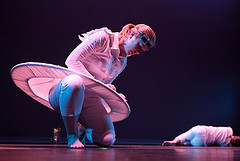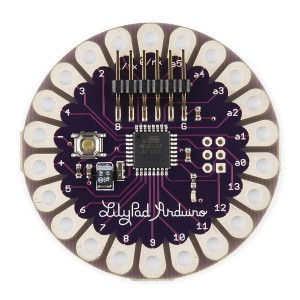Utam Moses (choreographer) and Eric Lindsay’s (composer)”The Space Between Us” is a collaborative electronic music and modern dance piece for computationally enhanced dancers and MAX/MSP, a programming language for interactive music and multimedia.

The costumes are embedded with LilyPad Arduino technology. One of the dancers’ (with the round skirt) costume combines LilyPad components and an XBee (wireless transmitter) together with pressure and flex sensors connected by conductive thread, which detects and transmits the movements of the dancer to the composer’s laptop, which are then used to generate and control sound within a MAX/MSP environment.

“The e-textiles facilitate interactivity between dancers’ movements and the music that accompanies their dancing, transforming the power dynamic between composer and choreographer by putting the power of live musical improvisation in the hands (body) of dancers. This relationship extends an unprecedented power to dancers, who are most often constrained by the decisions made previously by a composer.” – Eric Lindsay
For the costumes to achieve functionalities and expressive capabilities, sensors are to track the most communicative motions of the dancers, the music controls had to be sensitive to the gestures onstage but conspicuous enough so as to ensure the audience knew what movements elicited which kinds of sounds, and the costumes had to withstand duress from stretching, heat, and perspiration.

This project uses Arduino kit which is an open source technology. It is important as all Arduino boards are completely open-source, empowering users to build them independently and eventually adapt them to their particular needs. The software too, is open-source, and it is growing through the contributions of users worldwide. A worldwide community of makers – students, hobbyists, artists, programmers, and professionals – has gathered around this open-source platform, their contributions have added up to an incredible amount of accessible knowledge that can be of great help to novices and experts alike.


Excellent! It is interesting to note how instead of the dancers following the music in the traditional way, here, the music is following the dancers. How does this change the way the dancers move? If they are not necessarily timing their movement to the music, what is it like for them to lead the musical action?
This is a really interesting topic to discuss. Conventionally, dancers dance to the music. We talk about musicality, which is the ability to connect to and understand music that is being heard. It is essential for a dancer to have good musicality because dance is the birth of music. Music first. Dance later. That’s what my teacher has taught me. I am sure most dancers have been taught this way. Now if we reverse the order, let dance give birth to music. Is dance still dance?
Personally I wouldn’t consider it dance anymore. The dancer now becomes more like a composer or musician. The only difference is that he/she plays the music with his/her body as an instrument instead of using a violin or a piano. However, it is an interesting idea. Have you ever felt visually bored during a philharmonic concert with all musicians sitting still on the stage? (Yes I have.) You won’t get bored on this. It might evolve into a new form of performing art as it fuses the visuals and audios.
Great research! I find this particularly very interesting as it is an extremely innovative way to make use of wearable technology – creating music through movement.
Yuhao, thank you for sharing your thoughts on this . The idea of the dancer to become more like a composer or musician playing the music with his body/costume/space as amusical instrument is very apealing for the final project,what do you think? Do you heard of Keith Terry why is a percussionist/rhythm-dancer/educator and whose artistic vision has straddled the line between music and dance for more than four decades. As a self-defined “Body Musician,” Keith uses the oldest musical instrument in the world — the human body (his own) — as the basis for exploring, blending and bending traditional and contemporary rhythmic, percussive and movement possibilities.
Please let me know if you need any assistance on the electronics.